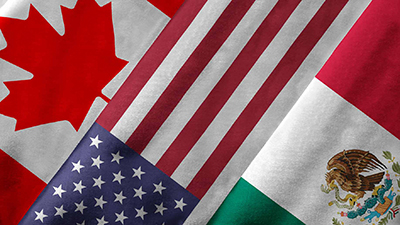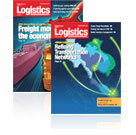Fine print trucking regulations snag NAFTA modernization talks

After fruitless talks south of the border, negotiators from United States, Canada and Mexico head north of the border to Montreal this month to try and work out snags that have stalled modernization attempts on the largest trade agreement affecting the three North American companies.
The U.S. Chamber of Commerce is strongly lobbying to tweak – not trash – the North American Free Trade Agreement (NAFTA.) And it’s not just transport companies who are leading the charge within the Chamber, U.S. Business Roundtable and other Washington lobbyist heavyweights.
But since the talks opened in August, the Trump administration – to the chagrin of many trucking executives – has been playing hardball in its “America First” approach to the negotiations.
Specifically, U.S. representatives are pushing for a hard fixed percentage of “Made in America” parts and raw materials for many industries, including automotive and textile. Opponents say that is futile and point to the 400% growth in cross-border trade since NAFTA was implemented 24 years ago.
President Donald J. Trump has said he is “psyched” to sever the popular pact among the U.S., Canada and Mexico. But transport executives, free trade advocates and most of the U.S. business community is madly trying to talk him out of anything like that.
Already, U.S. negotiators have stuck seemingly worthless language regarding Mexican trucks operating in this country into their demands. Specifically, they want to limit Mexican carriers’ ability to operate in this country, saying it does “material harm” to U.S. carriers and suppliers.
One quick look at some statistics will show how ludicrous that argument is. According to the DOT, there are only 38 Mexican-domiciled carriers with operating authority in this country. Those carriers have fewer than 400 trucks and less than 500 drivers.
By comparison, there are more than 700,000 American trucking companies with more than 7 million truck drivers already operating in this country in an industry responsible for 5 percent of the U.S. Gross Domestic Product.
It’s not just trucking playing defense. Textile and apparel executives, and their U.S. workers, are nervously eyeing the ongoing negotiations to modernize the agreement. Concerns around possible job losses in this sector are running high and rising.
While modernizing the 23-year-old NAFTA makes sense, its backers say withdrawing from the agreement would be a blow for the United States — one that would hit some states particularly hard. Ironically, those likely to suffer most would be Midwestern industrial states, heartland farm states, and border states like Texas and Arizona — nearly all of which voted to elect President Trump.
If you had read those statements in the mid-1980s, you might assume the textile sector was hoping trade talks would unravel, due to threats of foreign competition. Some still believe that to be the case, but they are mistaken.
“The reality is that the textile and apparel industry needs NAFTA,” the Chamber said in a note to its members. “And needs it badly.”
What a difference a generation makes, the Chamber says. To understand why NAFTA helps the U.S. textile and apparel industry compete, you need only understand one number: 97.
That is the percentage of clothes that are purchased every year by Americans and produced offshore. We still make clothes here in the United States — primarily for fast turns, for the military, and for special programs — and we always will. But the bulk of our clothing is sewn offshore.
Asian countries own a good chunk of that 97%. Six of our top ten clothing suppliers are in Asia with China leading the way at about 40% market share. But the ther four top suppliers are in the Western Hemisphere, and they include Mexico — one of two NAFTA partners.
That’s a good thing because clothing made in Mexico, and shipped back to the United States under NAFTA, contains a high amount of U.S. content. And obviously all those shipments back and forth across the border are good for transports.
Mexico has emerged as a top U.S. export market for U.S. textiles. More than one-third of all U.S. yarn and fabric exports are sent to Mexico, where many of them are incorporated into clothing. If we add in Canada, that number jumps to nearly 50%.
Scuttling NAFTA will unravel many of these Western Hemisphere supply chains, backers say, threatening hundreds of thousands of America’s textile and apparel jobs.
But jacking up NAFTA’s content requirements in a mistaken bid to induce even more U.S. content into these supply chains would also threaten American jobs. Well-documented auto industry concerns — that higher content requirements will lead to less, not more U.S. content — are mirrored in the textile and apparel industry as well.
Other proposals envision linking NAFTA up with other hemispheric partners so that the trade agreements would mirror how the industry views this part of the world — as one integrated region. Such ideas are key to ensuring NAFTA is successful for many years to come.
“The administration wants to increase the amount of U.S. and regional content in NAFTA trade, but we must look at this more holistically and ask instead how we can increase NAFTA trade overall,” the Chamber wrote in a white paper on NAFTA.
The distinction is critical, the Chamber says. That’s because if the U.S. settles for increasing content in NAFTA autos, textile and apparel trade, but that NAFTA trade drops due to the more burdensome requirements, the U.S. economy loses in the long run—and quite likely in the short run too.
In other words, does the U.S. want a bigger piece of an ever-shrinking pie, or do we want the pie to get bigger? Negotiators are working on that issue currently.

Article Topics
Latest in Logistics
LM Podcast Series: Assessing the freight transportation and logistics markets with Tom Nightingale, AFS Logistics Investor expectations continue to influence supply chain decision-making The Next Big Steps in Supply Chain Digitalization Under-21 driver pilot program a bust with fleets as FMCSA seeks changes Diesel back over $4 a gallon; Mideast tensions, other worries cited Four U.S. railroads file challenges against FRA’s two-person crew mandate, says report XPO opens up three new services acquired through auction of Yellow’s properties and assets More LogisticsSubscribe to Logistics Management Magazine

Find out what the world's most innovative companies are doing to improve productivity in their plants and distribution centers.
Start your FREE subscription today.
April 2023 Logistics Management

Latest Resources














